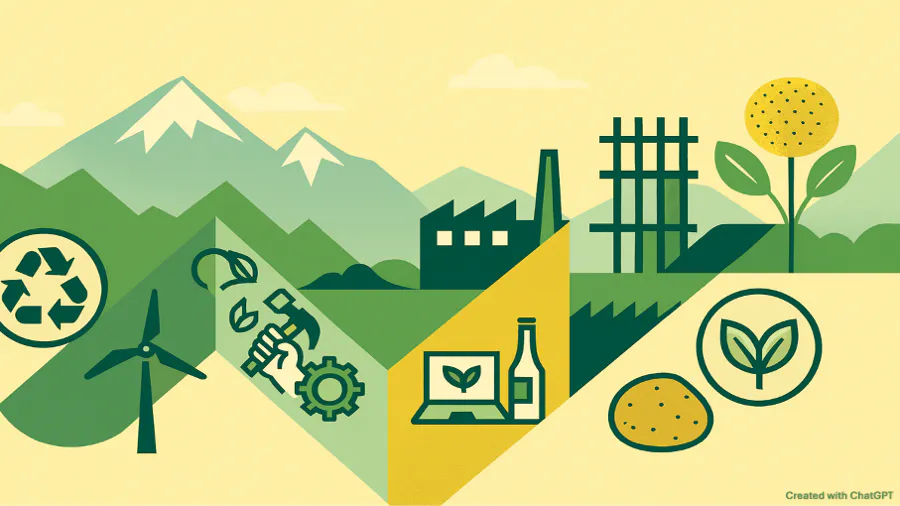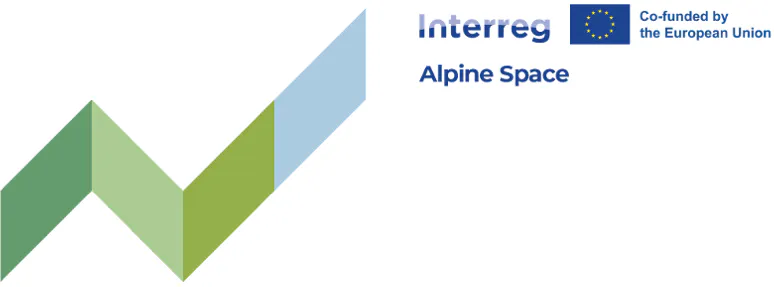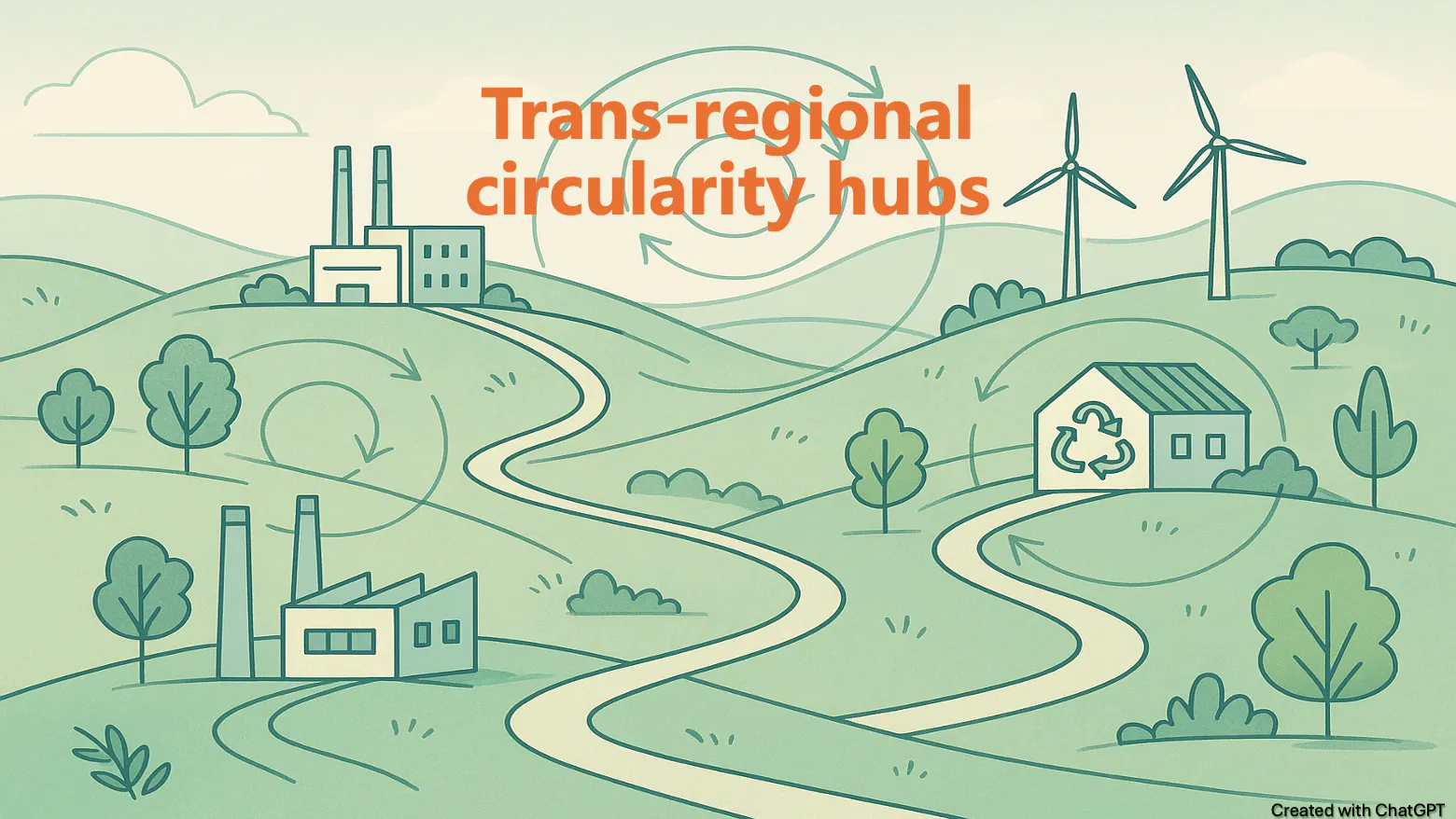Interreg Alpine Space Projects Pioneering Europe’s Circular Economy Transition
August 2025
Building on an earlier blog post about connecting the dots for a greener future through trans-regional circularity hubs (S'ouvre dans une nouvelle fenêtre), the following goes into more detail on the topic, providing examples from the Interreg Alpine Space Programme. Thanks go to colleagues from the programme for the inspiration and input that has made this focus on concrete examples possible.

In April 2025, Janine Benyus, renowned for her work on biomimicry, captured the essence of what circular economy strives for: Life creates the conditions conducive to life. In times of geopolitical uncertainty, climate crises, and dwindling natural resources, this vision is more than poetic – it is strategic. The circular economy approach offers a route to reshape Europe’s resource use, production models, and territorial development. The Alpine region, with its mix of ecological sensitivity, economic innovation, and macro-regional cooperation, is a living example of how circularity can move from vision to practice.
Europe’s Policy Momentum for Circularity
The EU has signalled a major policy shift by assigning the circular economy portfolio to a single Commissioner for the first time. Jessika Roswall, the new Environment Commissioner, oversees a consolidated mandate aimed at overcoming the fragmentation of earlier approaches.
Momentum is building. In 2025, the European Commission launched new initiatives culminating in the forthcoming Circular Economy Act. These measures build on the 2020 Circular Economy Action Plan and aim to move the EU beyond the “take-make-waste” model. By 2030, the EU aims to double the share of recycled materials in its economy – a crucial step given that only 12% of materials in EU products came from recycled sources in 2022.
New digital tools and legislative revisions (e.g., the Waste Electrical and Electronic Equipment Directive) aim to improve material recovery and reduce illegal waste shipments. These efforts support broader strategies such as the Clean Industrial Deal and the Competitiveness Compass, with circularity expected to deliver a quarter of the emission reductions required for climate neutrality by 2050.
But implementation won’t happen in Brussels alone. It depends on regional action.
The Alpine Region: A Living Laboratory for Circular Transition
The Alpine region is an ecological and economic hotspot, home to over 80 million people across seven countries. It faces climate pressures and biodiversity loss more acutely than many other parts of Europe. At the same time, the region hosts innovation hubs, strong governance cooperation, and decades of experience in transnational programming.
The Alpine region is an example for turning EU policy into territorial action. Three institutional instruments support this role: the EU Strategy for the Alpine Region (EUSALP), the Alpine Convention, and the Interreg Alpine Space programme. Together, they offer political alignment, ecological stewardship, and financial tools. Importantly, they enable governance beyond national borders—a prerequisite for scaling circular models that work across value chains, territories, and jurisdictions.
Macro-Regional Leadership: EUSALP’s Turn to Circular Economy
Since 2023, circular economy has become a cross-cutting theme across successive EUSALP presidencies. Switzerland laid the foundation by prioritising circularity alongside water and mobility, culminating in the Bad Ragaz Declaration. Slovenia carried the momentum into 2024, focusing on digital innovation and circular use of key Alpine resources – wood, water, food, and green hydrogen. The Austria-Liechtenstein presidency in 2025 now turns to practical implementation, especially in the construction sector.
This continuity across presidencies is not merely symbolic. It reinforces circular economy as a pillar of the Alpine Triple Transition – green, digital, and social. EUSALP’s approach has shifted from project promotion to systemic integration, embedding circularity in vocational training, policy coordination, and strategic agendas.
Interreg Alpine Space: A Territory-Rooted Driving Force
Where EUSALP defines political direction, the Interreg Alpine Space programme puts ideas into practice. With over 25 years of experience, it is a platform for transnational cooperation between administrations, businesses, research institutions, and civil society.

Its current programme counts the shift to a resource-efficient economy among its priorities. Rather than focusing narrowly on recycling, it supports systemic transformation in sectors such as construction, tourism, energy, and food. Many of its co-funded projects champion regionally rooted bio-based value chains, circular design, and material reuse—bridging innovation and tradition.
The programme’s approach is also human-centric. It invests in skills, behavioural change, and public awareness to ensure that circular models are not just technical solutions but social ones.
Projects that Make the Transition Tangible
Over the past two programming periods, Interreg Alpine Space has built a strong portfolio of circular economy projects that demonstrate how regional cooperation can translate vision into action. These projects go beyond theory: they deliver tested solutions, connect stakeholders across borders, and build capacity for broader implementation.
Bioeconomy & Local Value Chains
AlpLinkBioEco (S'ouvre dans une nouvelle fenêtre) (2018-2021): Developed a cross-regional Value Chain Generator, a digital matchmaking tool to link businesses into new bio-based value chains. This software matched producers and innovators across the Alps, resulting in four pilot bioeconomy value chains in sectors such as wood, agriculture, food/pharma, and green chemistry. By connecting the dots between supply and demand, AlpLinkBioEco turned strategic plans into concrete partnerships for circular bioeconomy development.
Forest EcoValue (S'ouvre dans une nouvelle fenêtre) (2022-2025): Supports forestry and wood businesses in Alpine communities in developing more circular value chains. The project launched bioeconomy innovation hubs focused on forest resources, developing tools for circular forest management (e.g. for optimizing use of timber and by-products), and piloting local enterprises that turn what was once logging “waste” into value-added products. This strengthens rural economies while incentivizing sustainable forestry practices.
Woolshed (S'ouvre dans une nouvelle fenêtre) (2024-2027): An innovative take on Alpine agriculture waste, Woolshed turns coarse Alpine wool – traditionally a low-value waste product – into a resource. By working with artisans and designers, the project is creating value-added eco-design prototypes (such as insulation materials, textiles or crafts) using coarse wool. It also set up local processing and supply chains for wool that had been mostly thrown away or burned. Woolshed showcases a viable circular solution rooted in regional raw materials and craftsmanship, adding income for farmers and reducing waste simultaneously.
Circular SMEs, Industry & Heritage
CIRCULAR4.0 (S'ouvre dans une nouvelle fenêtre) (2019-2022): Enhanced SMEs capacity to adopt digital technologies for circular business models. The project delivered a comprehensive Circular 4.0 Toolkit – including modular training courses, a circular business model canvas, financing schemes, and guidance on digital solutions like IoT and big data for resource efficiency. SMEs across the Alpine region used these tools to implement pilot measures: from eco-design of products, to digital tracking of materials, to new services for product life-extension. CIRCULAR4.0 showed how going digital can help traditional companies go circular.
AlpTextyles (S'ouvre dans une nouvelle fenêtre) (2022-2025): Focuses on reviving the Alpine textile industry through circular design and heritage. The project mapped regional textile value chains and surveyed consumer demand for sustainable apparel. It then co-created pilot textile collections that use recycled or locally sourced fibers and produce minimal waste, reconnecting modern designers with Alpine craft traditions. The results – including innovative upcycled clothing lines – were showcased at Milan’s premier textile fair Milano Unica in July 2025, proving that blending tradition with circular innovation can spark new life in a legacy sector.
ECOLE (S'ouvre dans une nouvelle fenêtre) (2022-2025): Works with industrial parks to shift from siloed operations to implement circular models. Through pilot deployments at multiple sites, ECOLE is introducing systems for sharing resources (like energy, water or excess materials) and for pooling waste management infrastructure among neighboring companies. By demonstrating these synergies, the project is formulating a transformation roadmap to scale such practices across the region’s industrial areas, turning traditional business parks into hubs of circular economy cooperation.
Circular construction
BAUHALPS (S'ouvre dans une nouvelle fenêtre) (2024-2027): Launched in late 2024, BAUHALPS is piloting circular construction models inspired by the EU’s New European Bauhaus (NEB) initiative. It combines the NEB’s principles of sustainability, aesthetics, and inclusion with rigorous lifecycle-based indicators. Expected outputs include a circular construction toolkit, feasibility-tested building prototypes using circular materials, and an action plan for transforming the Alpine building sector. These will serve as practical guides for Alpine municipalities, architects, and builders – helping them apply circular economy principles in real construction projects.
Circular food chains
CEFoodCycle (S'ouvre dans une nouvelle fenêtre) (2022-2025): Tackling food waste from farm to fork, CEFoodCycle established an international Circular Food Cycle Award that has recognized 35 innovative local initiatives fighting food waste. The project also set up five Circular Food Hubs across Alpine regions to connect stakeholders (farmers, retailers, charities) and provide them with lifecycle assessment (LCA) tools, matchmaking platforms, and best-practice exchanges for reducing waste. Notably, CEFoodCycle developed a digital decision-support platform (foodcycle.ai (S'ouvre dans une nouvelle fenêtre)) and published a white paper with an LCA toolkit to guide action along the entire food value chain. This goes on to create a legacy of knowledge and networks to drastically cut food waste in the Alps.These projects collectively show how circularity works across sectors, scales, and borders. By 2029, the programme aims to deliver 17 joint solutions and 12 pilot actions, with strong emphasis on replication.
Lessons for Europe: Scaling Circularity through Territorial Cooperation
The Alpine region illustrates how macro-regional cooperation, strategic alignment, and targeted funding can create fertile ground for circular economy transformations. Its success lies in bridging ambition with localised action—linking EU strategy to regional context, and innovation to tradition.
Europe can learn from this. First, circular transitions require sustained governance—across political cycles, regions, and institutions. Second, they need place-based strategies that account for territorial diversity. And third, they must go beyond pilots and embed circularity in regulations, funding, education, and everyday decision-making.
The Alps show that regional diversity is not a barrier, but a catalyst for transformation. Now is the time to weave circular principles into the fabric of European governance. The Alpine example is proof that with the right tools and cooperation, circularity is not just possible – it is already happening.
by Interreg Alpine Space
 (S'ouvre dans une nouvelle fenêtre)
(S'ouvre dans une nouvelle fenêtre)